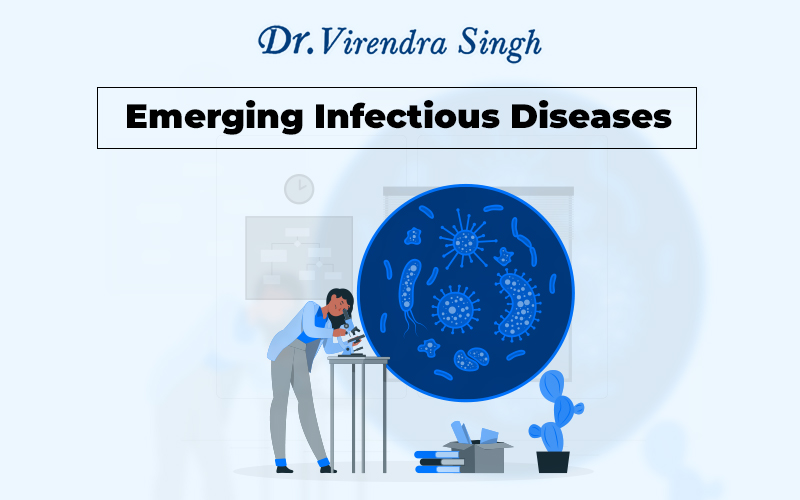
Infectious diseases are illnesses caused by harmful agents that get into your body. The most common causes are bacteria, fungi, viruses and parasites. Infectious diseases typically transmit from person to person, through tainted food or drink, and through insect bites. Some infectious diseases are serious and some are very minor. Infectious diseases will continue to influence the state of world health, offering difficult problems that need creative fixes. Fever and exhaustion are common signs and symptoms, though they might vary depending on the organism that is infected.
Mild infections may respond to rest and home remedies, while severe life-threatening infections may require hospitalization. Many infectious diseases, such as Chickenpox and Measles, can be prevented by vaccines. Additionally, frequent, thorough hand washing can help shield you against the majority of contagious infections.
What’s the Difference Between Infectious Diseases and Noninfectious Diseases?
Viruses and bacteria are two examples of hazardous organisms that enter your body from the outside and cause infectious diseases. Non-infectious diseases are those that are not caused by external organisms but rather by internal variables such as inheritance, anatomical abnormalities, aging, and environmental influences. The Flu, HIV, strep throat, Covid-19 and salmonella are all examples of infectious diseases. Cancer, congestive heart failure, diabetes and Alzheimer’s diseases are all examples of noninfectious diseases.
Infectious diseases are primarily caused by microorganisms such as viruses, bacteria, fungi and parasites. These viruses frequently pass from person to person and can enter the body through a variety of channels. Depending on the particular infection, they can cause outbreaks and epidemics with a range of symptoms. On the other hand, Non-infectious diseases are brought on by things like heredity, way of life, exposure to the environment, and age. This group includes ailments like heart disease, diabetes, and particular forms of cancer.
What are the Types of Infectious Diseases?
Infectious diseases can be bacterial, viral, parasitic or fungal infections. Transmissible spongiform encephalopathies (TSEs) are an uncommon group of infectious disorders.
- Viral infections
- Bacterial infections
- Fungal infections
- Parasitic infections
- Transmissible spongiform encephalopathies (TSEs disease).
What are Common Infectious Diseases?
Globally, infectious diseases are extremely prevalent, but some are more widespread than others. In the United States, for instance, 1 in 5 people contract the flu each year, while less than 300 people are found to have prion illnesses. Some of the most infectious diseases are listed here by type:
1. Common infectious diseases caused by bacteria:
- Tuberculosis: The infectious disease tuberculosis (TB) primarily affects the lungs but can also harm the spine, brain, or kidneys. The bacterium Mycobacterium tuberculosis causes tuberculosis (TB). The germs typically target the lungs, but they can harm any other area of the body. When treating Tuberculosis, Dr. Virendra Singh takes a thorough, patient-centered approach. He emphasizes on giving each Tuberculosis patient individualized care using his broad medical knowledge and sympathetic personality.
- Strep throat: A bacterial infection known as strep throat can cause itchy and painful symptoms in the throat. Only a small percentage of sore throats are caused by streptococcus. strep throat can cause issues such as kidney inflammation or rheumatic fever. Rheumatic fever can manifest as a specific type of rash, heart valve dysfunction, and painful, inflamed joints.
- Whooping cough: Pertussis, sometimes known as whooping cough, is a very contagious respiratory ailment. It is frequently distinguished by a harsh hacking cough followed by a high-pitched breath intake that resembles a “whoop.” Before the vaccine was created, whooping cough was thought to be a disease that only affected children.
2. Common infectious diseases caused by viruses:
- Common cold & cough: The common cold is an illness affecting your throat and nose. Colds are probably the most common illness. Every year, adults have an average of two to three colds, and kids get even more. Colds are more common in the spring and winter. There are more than 200 viruses that can cause a cold, but rhinoviruses are the most prevalent kind. Dr. Sheetu Singh is a respiratory health expert with a plethora of knowledge who can give you the expert advice and care you require. By contacting Dr. Sheetu Singh, you’re taking a proactive step toward managing your cough and cold effectively.
- The Flu (influenza): The respiratory system includes the nose, throat, and lungs, which are all affected by the flu (influenza). Although influenza is usually referred to as the flu, it is distinct from stomach “flu” viruses that cause vomiting and diarrhea. Most flu sufferers recover on their own. But sometimes influenza and its side effects might be dangerous.
- COVID-19: Coronavirus disease is an infectious condition brought on by the SARS-Cov-2 virus. Most virus-infected people will develop a mild to severe respiratory illness, but they will recover without the need for special treatment. However, they will become seriously ill and require medical attention. Serious sickness is more likely to strike older persons and those with underlying medical illnesses including cancer, diabetes, cardiovascular disease or chronic respiratory disease.
Who is Most at Risk To Contracting Infectious Diseases?
People at higher risk of contracting an infectious disease include:
- those whose immune systems are weakened or compromised, such as cancer patients, HIV patients, or people taking particular medications.
- Pregnant women, young children and adults over 60.
- Those who are not vaccinated against common infectious diseases.
- Healthcare workers.
- People who go places where they can be exposed to mosquitoes that spread diseases including Malaria, Dengue and Zika.